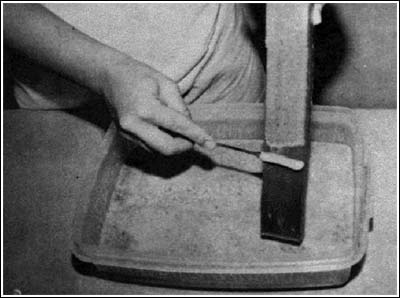

 |
||||||||||||
 |
||||||||||||
| Microworm Culture for Aquarium Fish Producers | ||||||
| Page 2 of 2 | Back to Page 1 | |||||
The culture should be kept in a well lighted area at room temperature, 68-85°F. Microworms can withstand temperatures below 32°F but greater daily production can be expected at higher temperatures; however, cultures last longer at lower temperatures. The microworms feed on the yeast and bacteria produced from the oatmeal. After 3 to 7 days, the surface of the media will appear to shimmer with the movement of the microworms, and they will start climbing up the sides of the container. The microworms are harvested by simply scraping them from the sides and top of the container. A paint-stirring stick laid on the media provides additional surface from which to harvest (Figure 2). The 8" x 12" culture will provide a harvest of approximately 1 to 1-1/2 teaspoons of microworms daily for three weeks or more. 
Figure 2 Maintaining the Culture The surface of the culture should be stirred every week to maintain production. As the yeast utilizes the oatmeal, the mixture will become thin and soupy, although the production of the worms will remain the same. A piece of sponge can be placed on the media to soak up the excess moisture. Eventually, as the oatmeal is exhausted, reducing the nutrient supply for the yeast, the harvest of microworms diminishes and a new culture should be started. Additional Microworm Cultures Other recipes for microworm cultures include (1) cornmeal, baker's yeast, and water; (2) baby oatmeal cereal, baker's yeast, and water; (3) Instant Ralston cereal, brewers yeast, baker's yeast, and beer; and (4) baker's yeast and water. My experience has been that cornmeal produces fewer microworms than rolled oats. The other recipes use ingredients that are much more expensive than the rolled oats used for livestock feed and are therefore less economical for the large scale hatchery production. The microworms can be fed alone or in combination with other foods such as brine shrimp, rotifers, zooplankton, egg yolk, dry diet, etc. Studies at our laboratory have shown that growth and survival of fish fry fed microworms is not significantly different from those fed brine shrimp. Microworms are especially useful for species of fish whose fry are too small to initially take a newly hatched brine shrimp nauplii. However, a feeding program utilizing a combination of food items is probably the best option because it provides for a back-up food supply in case of production failures and is better able to meet nutritional requirements of the fish fry. -------------------------------------------------------- Footnotes
-------------------------------------------------------- The Institute of Food and Agricultural Sciences is an equal opportunity/affirmative action employer authorized to provide research, educational information and other services only to individuals and institutions that function without regard to race color, sex, age, handicap, or national origin. For information on obtaining other extension publications, contact your county Cooperative Extension Service office. Florida Cooperative Extension Service / Institute of Food and Agricultural Sciences / University of Florida / Christine Taylor Waddill, Dean -------------------------------------------------------- Copyright Information This document is copyrighted by the University of Florida, Institute of Food and Agricultural Sciences (UF/IFAS) for the people of the State of Florida. UF/IFAS retains all rights under all conventions, but permits free reproduction by all agents and offices of the Cooperative Extension Service and the people of the State of Florida. Permission is granted to others to use these materials in part or in full for educational purposes, provided that full credit is given to the UF/IFAS, citing the publication, its source, and date of publication. 
SimplyDiscus.com gratefully thanks the Florida Cooperative Extension Service for permission to use this article. Please visit them at http://edis.ifas.ufl.edu/ |
 |
|||||
| About Us :: Message Board :: Chat | |||||
| Library :: Photo Gallery :: Links & Resources :: Breeders & Sponsors :: Merchandise | |||||
| Website designed by: EthanCote.com | © 2001-2004, SimplyDiscus.com. All Rights Reserved. | ||||